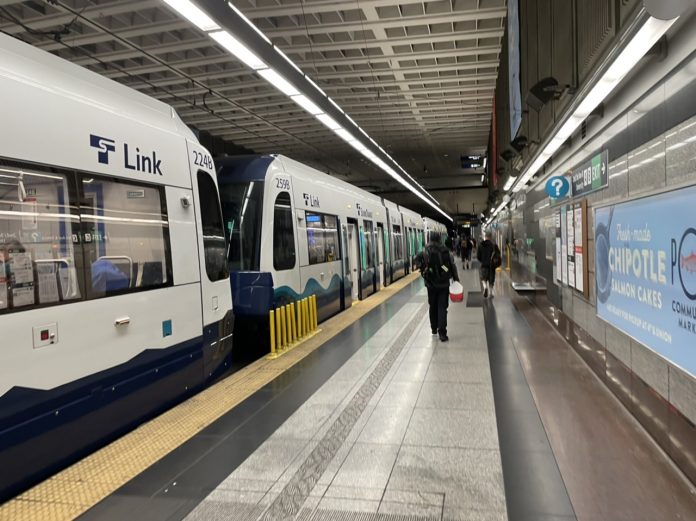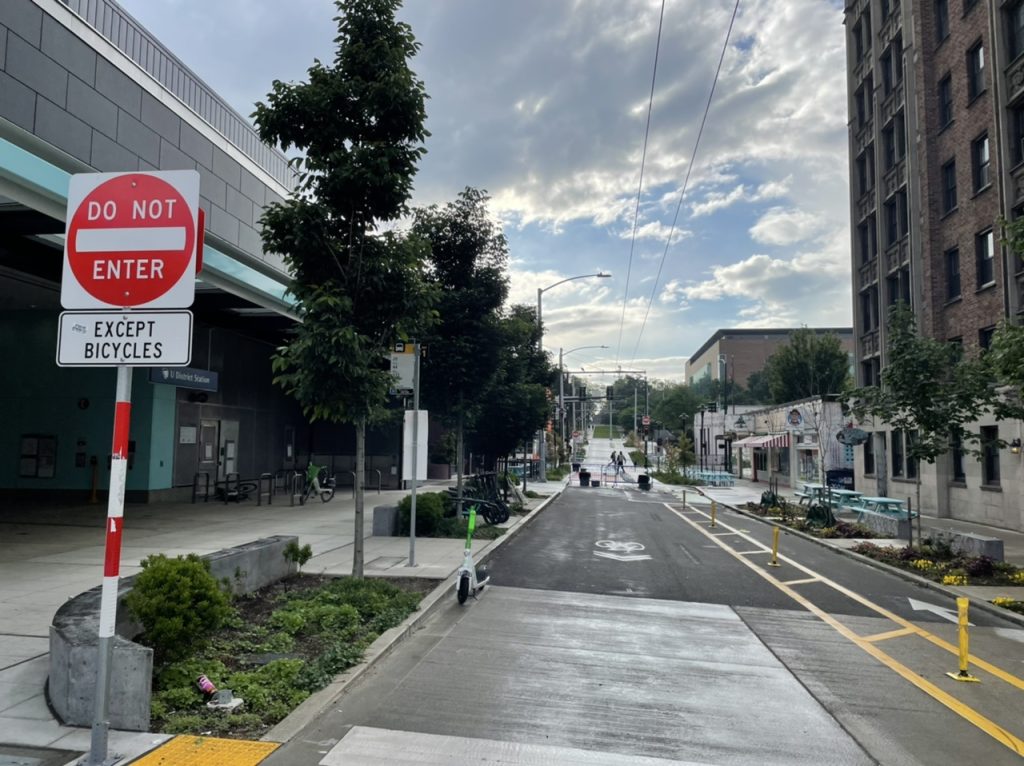This week’s Transpo Notes roundup touches on a mix of bus, train, ferry, and driving stories, including:
- A long-awaited University District bus stop opening;
- Coming fixes to a leaky U District Station ceiling;
- Explanation for why four-car Link light rail trains aren’t the norm;
- Upgrades coming to a trolley bus traction power substation;
- An end to state ferry building contract negotiations;
- A check-in on Pierce Transit hiring progress; and
- Proposed toll rate reductions for the Tacoma Narrows Bridge.
Long-awaited U District Station bus stop soon to open
King County Metro has announced that the long-awaited bus stop on NE 43rd Street in front of U District Station will open this month. The bus stop was supposed to open last fall when the station did, but supply chain and construction delays meant that it couldn’t. For instance, Metro and the City of Seattle still needed to get overhead catenary wires strung up and energized. Those wires stretch along NE 43rd Street from 15th Avenue NE to 12th Avenue NE and then follow 12th Avenue NE north to the mainlines on NE 45th Street.
Metro plans to begin using the bus stop on June 25th. That means the street will also be fully open to westbound-only buses and bikes. People biking can already use the protected bike lane in the eastbound direction. The first electric trolleybuses will use the street on June 27th.
An estimate by Metro suggests that about 16,000 riders on weekdays will benefit from the stop, providing direct access to the Link light rail station. The new path will also improve speed and reliability of buses and offer better to new bus layover space on 12th Avenue NE. Routes benefiting from the new bus stop and path include Routes 20, 44, 49, 70, and 372.
Leaky U District Station ceiling to be fixed soon
At U District Station, riders quickly realized that there were leaks coming from the ceiling, landing water drops directly onto platforms. The Urbanist asked Sound Transit what, if anything, would be done about this problem; the agency says that corrective work should be coming this summer.
John Gallagher, a Sound Transit spokesperson, provided us context for why and where there is a leak. “The location of the leak is on the north wall of the south entrance headhouse. We actually installed an observation well at this location and found there is constantly standing water at this location, so we assume it is ground water,” he said by email. “The issue is with the interface between the station’s underground concrete lid and a structural support beam at the surface level to support the UW building planned for construction above.”
Gallagher also said that the agency has definitive plans in motion to correct the problem. “We have worked to develop both a revision to the lid waterproofing membrane and to install a permanent sump pump at the leak location to address the issue,” he said. “We are currently working through the permit process with the city needed for this construction and hope to begin work in July or August.”
Sound Transit has filed an insurance claim to cover the remedial work.
Why four-car Link trains aren’t the norm right now
When Northgate Link launched, Sound Transit had planned to operate four-car trains for normal service. Seasoned riders, however, will notice that many trains operate with only three cars, even during peak hours — though the agency is good about operating full-length trains during special events. We asked why that is.
Sound Transit’s John Gallagher offered some insight as to why. “While we are still running four-car consists, we have three-car consists now so that we can do some needed maintenance on the fleet while ridership is still relatively low,” he said. “We are planning on having all four-car consists for the upcoming Future Ready work.” Riders will likely be relieved that four-car trains will partially mitigate service disruptions if Sound Transit does proceed ahead with deep service cuts during its Future Ready program, which will involve months of maintenance work on the Link Line 1 and start in the middle of July.
Metro is upgrading a traction power substation in Uptown
Trolleybuses operated by Metro use traction power systems to energize overhead catenary wires commonly seen across Seattle. An important facility in the network is the Broad Street Substation in Uptown, right near Seattle Center. It powers 14 trolley bus lines across the city and is poised to get some upgrades soon.
Metro has put out a notice for a design-build contract that entails replacement and upgrade of substation systems, including AC breakers, transformers, and rectifiers. Work will need to be performed sequentially such that the systems remain energized throughout the process. Most of the design work has already been completed, paving the way for construction to begin as soon as early next year. Metro expects construction to take about two years to complete given the complicated nature of the work. Cost is estimated somewhere between $4.5 million to $5.5 million.
Washington State Ferries ends shipbuilding contract negotiations with Vigor
This week, the Kitsap Sun reported that negotiations between Washington State Ferries (WSF) and shipbuilder Vigor collapsed. That’s a big blow to WSF because Vigor was supposed to build five new Olympic class ferries — the newest generation and largest vessel type in the fleet — using new hybrid diesel-electric technology.
Vigor isn’t new to ferry building in Washington, having delivered the latest Olympic class ferries to the fleet with the most recent — the M/V Suquamish — in 2018. That’s partly why it was a shoe-in for the latest assignment to design the new vessels and construct them. However, Vigor’s contract terms and pricing proposals were not in line with WSF’s expectations, which apparently led the agency to pull out of construction negotiations.
With negotiations terminated, WSF is moving to reopen the bidding process this summer for third-party vessel construction contract proposals. This will have the consequence of delaying delivery of the first vessel until about June 2027, but given how far apart Vigor and WSF must have been on contract terms it may be a good long-term decision. Any delay in delivery, however, will likely continue to present operational challenges for WSF, which has long-struggled with having available reliable equipment to serve routes. WSF still plans to have Vigor complete its design work for the new vessels, which will be used by whatever company picks up the construction contract.
Pierce Transit operator levels hanging in there
Just like Metro and Community Transit, Pierce Transit is still on the hunt to backfill transit operator positions and maintain service levels. The agency has a budget for 515 operators but only 430 positions are currently filled, enough to cover all full-time positions needed. The 85 remaining positions are usually meant to be for part-time operators that provide further operational relief and coverage. Pierce Transit may finally be catching up in their hiring efforts to fill these part-time roles.
Last week, the agency was completing training for 16 operators with seven of them moving into full-time roles, essentially keeping the agency staffed up with 430 full-time operators and the moving remainder of new operators into part-time roles for now. This week, Pierce Transit also began a new training course for 18 new operators, which typically takes six to ten weeks to complete. While this is certainly positive, given the amount of time it takes to train up operators, there’s a fair chance that agency will continue to tread water on replacing operators as some move onto other roles or separate from Pierce Transit in the intervening weeks.
| Month | Operators |
| April | 430 |
| May | 430 |
| June | 423* |
Pierce Transit is offering competitive pay with hourly wages at $26.55.
Push back on Tacoma Narrows Bridge toll rate reductions
This week, the Washington State Transportation Commission (WSTC) opened up a survey on toll rate reductions on the Tacoma Narrows Bridge. The commission is considering three different toll rate reductions, which could amount to 75 cents. Of course, the commission is also taking general feedback on the proposal, too.
The three toll rate reductions under consideration are:
- A 75-cent toll rate reduction for all vehicles;
- A 75-cent toll rate reduction for two-axle vehicles; and
- A 75-cent toll rate reduction for two-axle vehicles with a per-axle multiplier applied for vehicles with three or more axles.
The toll rate reduction is made possible by $130 million in funding pledged from the state general fund, which the Washington State Legislature approved this session. This funding will reduce bonding repayment costs, hence the savings to motorists, if adopted by the WSTC.
However, the funding allocation comes directly out of the state general fund, which is supposed to be used for things like education, healthcare, and housing. If adopted, the toll rate reduction will generally benefit some of the wealthiest drivers in the region and do nothing address the state’s growing mobility needs. The best feedback to the WSTC may be to reject the toll rate reduction entirely and apply it to the fewest possible drivers if it is adopted to save state general fund money for better purposes.
Stephen is a professional urban planner in Puget Sound with a passion for sustainable, livable, and diverse cities. He is especially interested in how policies, regulations, and programs can promote positive outcomes for communities. With stints in great cities like Bellingham and Cork, Stephen currently lives in Seattle. He primarily covers land use and transportation issues and has been with The Urbanist since 2014.



